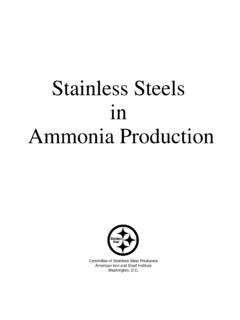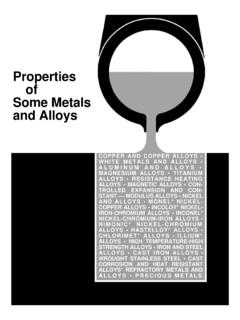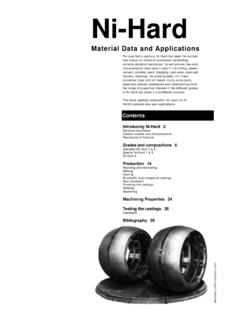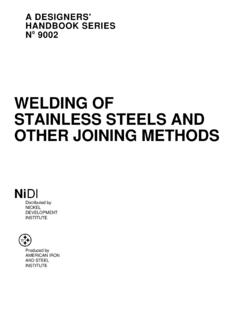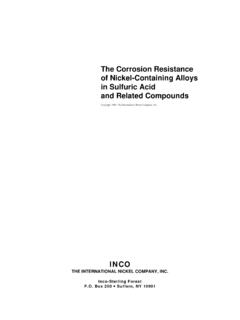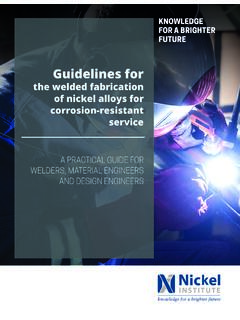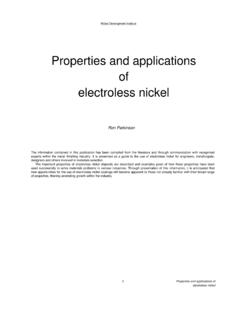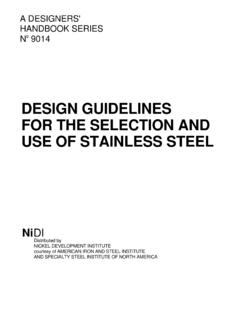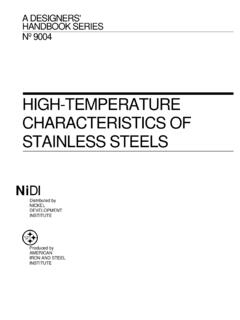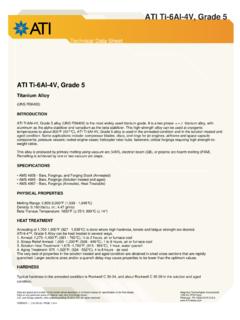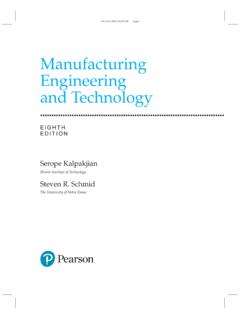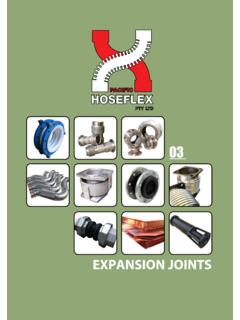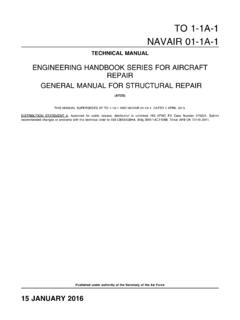Transcription of STAINLESS STEELS FOR MACHINING - Nickel Institute
1 STAINLESS STEELS FOR MACHINING A DESIGNERS' HANDBOOK SERIES Committee of STAINLESS Steel Producers American Iron and Steel Institute 1000 16th Street, Washington, 1 TABLE OF CONTENTSP reface .. 2 Introduction to STAINLESS STEELS .. 4 Identification .. 4 Corrosion Resistance .. 9 High-Temperature Corrosion Resistance.
2 19 Mechanical and Physical Properties .. 22 High-Temperature Mechanical Properties .. 40 Low-Temperature Mechanical Properties .. 42 The Machinable Family of STAINLESS STEELS .. 44 Free- MACHINING STAINLESS STEELS .. 46 Buy a Better Bar .. 48 STAINLESS STEELS for Screw Machine Operations .. 50 Machinability vs. Cost .. 51 Design Hints for Screw Machine Parts .. 52 Good Shop Practices .. 58 Cleaning and Passivating .. 59 The Free- MACHINING STAINLESS STEELS .. 60 Types 303 and 303 Se STAINLESS STEELS .
3 60 Type 430F STAINLESS Steel .. 62 Type 416 STAINLESS Steel .. 64 Type 420F STAINLESS Steel .. 66 Page 2 PREFACER eference to STAINLESS steel is often made in the singular sense as ifit were one material. Actually there are approximately 150 separate and distinct compositions, each one formulated to serve specific end-use and/or manufacturing requirements. STAINLESS STEELS are only one segment of the steel spectrum, but they serve a multitude of applications from brightly polished consumer pro-ducts to machinery and equipment for tough industrial environments.
4 The variety of STAINLESS STEELS available today provides a veritable palette of properties, from specially formulated alloys capable of per- forming in the most difficult environments to a wide selection of types ideally suited for MACHINING or other fabrication operations. Why Upgrade to STAINLESS STEELS ?Upgrading to STAINLESS STEELS rewards both manufacturer and user. Among the more obvious benefits are: Corrosion and Heat Resistance Stainlesssteels, depending upon the composition, resist corrosion by many acids, moisture, atmospheric conditions, and other aggressive environments at low or high temperature.
5 Strength Parts often can be made stronger and tougher with STAINLESS STEELS than with mild STEELS or nonferrous metals .. including parts exposed either to high temperatures or to hundreds of degrees below freezing. Durability The combined qualities of corrosion resistance and strength result in products capable of providing a lifetime of useful, trouble-free service. Accordingly, manufacturers' reputations are enhanced by products made of STAINLESS . Low Maintenance Homeowners and industrial users alike prefer STAINLESS STEELS because there is no need for protective coatings or other special surface treatments that can deteriorate or necessitate periodic maintenance.
6 Appearance Whether a product is highly polished or just routinely made on a screw machine to a 63 RMS as-machined finish, its surface presents an enduring bright, metallic lustre. Fabrication Flexibility STAINLESS STEELS can be machined, cold formed, forged, extruded, or welded by contemporary fabricating tools and techniques. Designers will find among the STAINLESS STEELS , properties capable of meeting a wide range of manufacturing and end-use requirements. Selecting a STAINLESS SteelEarly uses of STAINLESS STEELS were limited to such applications as gun barrels, cutlery, and nitric acid tanks.
7 As industry began to exploit the full potential of these corrosion resistant metals, new compositions were developed to accommodate requirements for greater resistance to corrosion, greater strength levels, different fabricating characteristics, resistance to elevated temperature, etc. 3 For example, Type 304, one of the most frequently used STAINLESS steel compositions having application in a broad range of products from cookware to chemical plant equipment, has several variations. For greater resistance to corrosion, especially in marine environments, specifiers often select Type 316, which has a higher alloy content than Type 304.
8 Type 305, on the other hand, has a lower work-hardening rate than Type 304 and is better suited to cold forming operations, while Type 303 is the more machinable variation of Type 304. Selection of the proper STAINLESS steel from the many types available requires an evaluation based upon five important criteria. Listed in order of importance, they are: Corrosion or Heat Resistance the primary reason for specifying STAINLESS steel. The specifier needs to know the nature of the environ-ment and the degree of corrosion or heat resistance required.
9 Mechanical Properties with particular emphasis on strength, at room, elevated, or low temperature. Generally speaking, the combina-tion of corrosion resistance and strength is the basis for selection. Fabrication Operations and how the product is to be made is a third-level consideration. This includes MACHINING , forming , welding, etc. For parts requiring more than one fabrication operation, the most difficult usually takes precedence. Total Cost To put everything into proper perspective, a total value analysis is appropriate which will consider not only material and pro-duction costs, but the cost-saving benefits of a maintenance-free prod-uct having a long life expectancy as well.
10 Availability The final step in the selection /specification process is to determine the availability of the candidate material(s). Depending on the quantity involved, an inquiry can be prepared and submitted to a steel service center or directly to a mill that produces STAINLESS steel. (A list of producers participating in this booklet appears on the back cover.) Direct contact with one or more producers can be beneficial because possible alternative, lower-cost materials might be suggested. Although selection is based primarily on the ability of the material to meet end-use requirements, specifiers and buyers should not overlook manufacturing, especially MACHINING , which can be improved by material selection.
